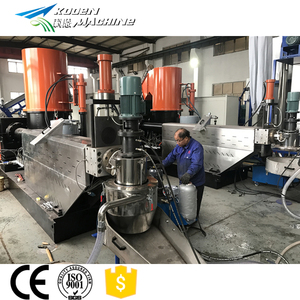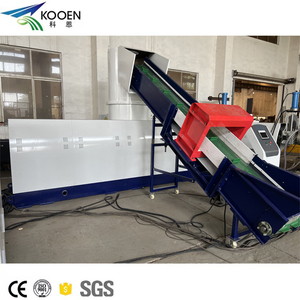
All categories
Featured selections
Trade Assurance
Buyer Central
Help Center
Get the app
Become a supplier

(144 products available)



























A side feeder extruder, also known as a side feeding extruder, is a unique kind of machine that feeds materials from the side into the barrel. It is an integral part of the plastics machinery industry. Side feeder extruders are helpful in the processing of different materials like plastics, rubber, and food. They are available in different variations that can be customized to meet clients' needs.
Separate screw and barrel
A side feeder extruder with separate screw and barrel refers to a design in which the feeding mechanism and the main conveying and melting system are distinct components. Generally, a side feeder extruder has a barrel where the side feeder is typically mounted on the side of the main extruder barrel. The main melting and conveying screw resides within the separate barrel. This variant of the side feeder extruder is beneficial, as it allows independent design optimization of the feeder and extruder sections to suit specific material requirements.
Side shoot feeder
A side shoot feeder extruder is a specific configuration within side feeder extruders where the feeder 'shoots' or directs the material into the extruder from the side. This setup enhances material distribution within the extruder, improving processing efficiency and consistency. The side shoot feeder is excellent for adding solid additives or fillers to a melt polymer stream, such as glass fiber, calcium carbonate, etc. It can also incorporate reactive extrusion processes where solid reactants need to be introduced into the reactor/extruder continuously.
Side vented feeder
Side vented feeders in extruders refer to a configuration where vents on the sides of the extruder are present, allowing for the escape of volatiles or moisture during processing. This side feeder extruder venting mechanism improves the quality of the extrudate by reducing contaminant levels. It also enhances the material flow, processing productivity, and efficiency. Side vented feeders are particularly useful for handling polymers and other materials with moisture or volatile organic compounds.
High Torque Side Feed Extruder
High Torque Side Feed Extruder models are designed to process materials that require a high-strength driving force for optimal feeding and melting, such as high-viscosity or high-throughput applications. Its motor generates a higher twisting force, usually measured in Newton-meters (Nm), compared to standard side-feed extruders. They are primarily used in industries such as rubber compounding, plastics recycling, and multi-material blends.
Capacity:
The ability of an extruder feeder indicating the quantity of substances or materials it can process or supply in a designated time frame is known as the side feeder extruder's capacity. For example, it may be denoted in kilograms per hour (kg/h) or other applicable units.
Temperature range:
The temperature range of a side feeder screw extruder refers to the operating temperature range at which the extruder can function. This temperature range determines the material's melting and shaping ability, and different materials need to be processed at corresponding temperature ranges.
Degree of vacuum:
The degree of vacuum of a side feeder extruder refers to the level of vacuum or pressure inside the extruder during operation. Maintaining a certain vacuum degree can help control the material's flow, compression, and mixing, as well as enhance the degassing and drying effect.
Motor power:
The motor power of a side feeder extruder is the power output of the motor driving the screw and other components that power the extruder. Motor power is usually measured in kilowatts (kW) or horsepower (HP).
Screw diameter:
The diameter of the screw of a side feeder extruder refers to the diameter of the screw used to feed and plasticize the material. The diameter of the screw will affect the squeezing and mixing effects of the materials.
Material:
The body of a side feeder extruder is made of alloy tool steel, with a high-temperature and high-pressure anti-wear coating on the outside. When working at a high temperature, it can ensure the stability of material properties and effectively prevent corrosion.
When using a side feeder extruder, it is crucial to take proactive maintenance measures to guarantee its steady performance and longevity. Below are some maintenance methods pertinent to a side feeder extruder:
Regular cleaning:
Periodically clean the inner and outer portions of the side feeder extruder to prevent residual material from accumulating, resulting in contamination or blockages. Cleaning agents can be utilized to ensure cleanliness and hygiene.
Lubrication and oiling:
Proper lubrication is critical to preserving the longevity and functionality of the side feeder extruder. Regularly apply lubricant to the drive system, bearings, etc., in accordance with the manufacturer's requirements. Lubricants lessen friction and boost operational efficiency.
Inspection and adjustment:
Perform regular inspection and adjustment of the components of the side feeder extruder. Check for signs of wear and tear, looseness, or malfunction of the screws, barrels, side feeders, and other parts. Make necessary adjustments, such as tightening, replacing, or repairing, to ensure the equipment's normal operation and stability.
Pay attention to the environment:
Extruders should be kept in appropriate surroundings. Be sure to avoid exposing the equipment to wet, dusty, or high-temperature environments for long periods of time, which may result in damage to the parts or electrical system of the equipment. Also, ensure that devices such as ventilators are utilized to keep the room well-ventilated and lessens the temperature within the room.
The side feeder extruder is used in various industries for multiple applications. Below are some of the most prominent applications of the side feeder extruder:
Plastic Recycling
Side feeder extruders are applied in recycling plants to reprocess waste plastic materials. The extruders can efficiently handle and melt different types of plastics. They also allow for the addition of recycled fillers and additives into the molten plastic.
Food Processing
In the food industry, side feeder extruders are used for conveying, cooking, and texturizing food products. Materials such as soybeans are processed with side feeder extruders to produce textured vegetable protein (TVP). Moreover, the extruders can incorporate flavors, nutrients, and preservatives into the food products.
Rubber Processing
Side feeder rubber extruders are utilized in tire and rubber product manufacturing. The feeding mechanism of the extruder allows for precise incorporation of additives like carbon black, silica, and antioxidants into the rubber mix. After mixing, the homogenized rubber compound is directly shaped into products via the die insert of the extruder.
Biomass Pellets Production
Side feeder extruders can be used to produce biomass pellets for renewable energy. They are capable of processing different types of biomass materials like wood sawdust, straw, and agricultural residues. Moreover, the additives and binders can be extruded with the biomass material through side feeder extruders.
Pharmaceuticals
In the pharmaceutical industry, side feeder extruders are used for blending and processing medication ingredients. The extruders have good capability of mixing various chemical compounds. They can also be applied in uninterrupted feeding of raw materials to reactive and fluid bed systems.
Wholesale buyers considering investing in a side feeder extruder for their production line should take the following critical factors into account before purchasing:
Production Capacity:
Opt for machines that can handle the specified production volume as well as the intended applications. A device with a lower output may meet the requirements, but one with a higher output may also be cost-effective to accommodate future growth.
Material Compatibility:
Ensure that the materials which the side feeder extruder can handle match the ones used in the production line. Consider features such as temperature control, pressure control, and screw design to ensure efficient processing of specific materials.
Energy Efficiency:
With rising energy costs, selecting a machine that optimizes extrusion processes to minimize energy consumption is critical. Consider the motor's power rating and the machine's overall energy-efficient design.
Space Requirements:
Check the dimensions of the extruder system to determine whether it fits well into the existing production space with all the necessary connections and arrangements.
Maintenance and Support:
Select the model for which local suppliers provide required spare parts and repair services. Consider the lack of technical support and the long learning curve associated with the maintenance and operation of complex machines.
Operator Safety:
Choose an item that complies with safety features and regulations to protect the workforce. This may include emergency stop buttons, safety enclosures, and guidance for proper handling and maintenance practices.
Q1: What materials can a side feeder in an extruder handle?
A1: Side feeders can handle various materials, including polymers, additives, fillers, and masterbatch. Their ability to accommodate different material shapes and sizes makes them versatile.
Q2: Can side feeders extrude materials with different densities simultaneously?
A2: Yes, side feeders can handle materials with different densities simultaneously. They can be combined and processed together by introducing them into the extruder, which is economical and beneficial for enhancing the product's properties.
Q3: What is the difference between a side feeder and a top feeder in an extruder?
A3: The location of material feeding is the main difference between side feeders and top feeders. While top feeders inject the material into the extruder from the top, side feeders are positioned on the side. Due to the improved material distribution and homogenization, side feeders frequently handle larger quantities of materials and complex compositions than top feeders.
Q4: What are the trends in side feeder technology development?
A4: The development of side feeder technology is moving toward better feeding capacity, energy efficiency, and automation. To increase the feeding capacity, rotors with variable speeds, double-screw mechanisms, and new feeder designs are being used. Additionally, side feeders are being made more energy-efficient and simple to operate, thereby lowering operating costs and boosting productivity.